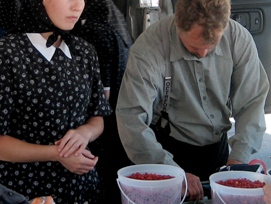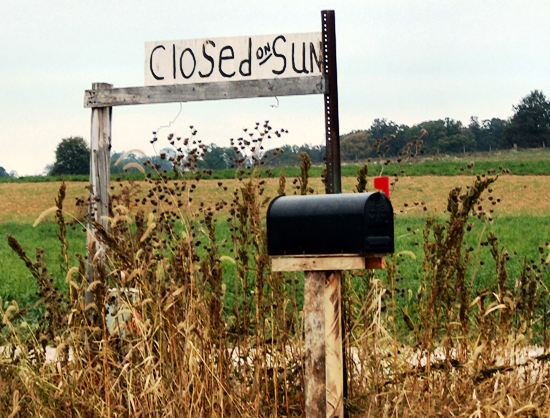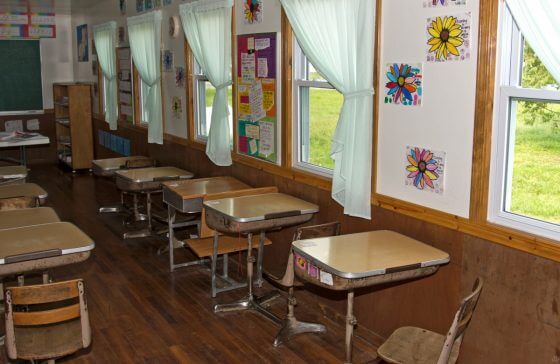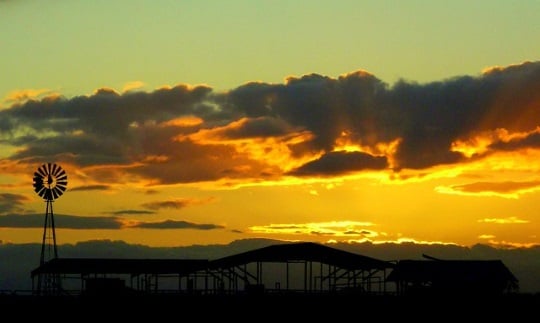The 3 Hutterite Groups
Since the mid-1800s, the Hutterites have comprised 3 main groups–the Lehrerleut, the Dariusleut, and the Schmiedeleut.
The Lehrerleut are considered the most conservative, with the Schmiedeluet being the most progressive, and Dariusleut somewhere in between.

However, in 1992, The Schmiedeleut experienced an internal division, creating 2 separate Schmiedeleut groups.
Donald Kraybill’s Concise Encyclopedia of Amish, Brethren, Hutterites, and Mennonites gives some background on the Hutterites and this particular division. From the Concise Encyclopedia:
Schmeideleut Hutterites, Gibb Group
The Schmiedeleut formed in 1859 in Russia when Michael Waldner (1823-1889) reinstituted the practice of communal property. They were a single group from 1859 until they divided following an internal dispute in 1992. This group became known as the Committee Hutterites or the Gibb Group because a non-Hutterite banker whose surname was Gibb supported their separation from the Kleinsasser Group. Although the Gibb Group is more conservative in cultural practice than the Kleinsasser Group, the two Schmiedeleut branches are the most progressive of the Hutterite groups. Twice as large as the Kleinsasser Group, the Gibb Group has about 120 colonies. Nearly half of the group’s members live in Manitoba, and the rest–about 2,450 members in 61 colonies–live in Minnesota and North and South Dakota.
The three other Hutterite groups have their own separate entries in the Concise Encyclopedia as well, in addition to a longer general entry on Hutterites, which explains Hutterite beliefs and communal colony life.
Concise Encyclopedia of Amish, Brethren, Hutterites and Mennonites contest winners
Thanks to everyone who entered this book giveaway contest. And thanks to Donald Kraybill for sharing his thoughts on the diverse Anabaptist groups of North America. If you didn’t have a chance to read it, you can find an interesting interview with Kraybill here, and a guest post on the research and writing process here.
Here are the winners of a copy of the Concise Encyclopedia of Amish, Brethren, Hutterites, and Mennonites. I used random.org to select winners.
If you commented more than once that is super–we love comments!–but I just counted the first comment for contest purposes:
Donna Young (comment #41)
Anita (blog entry-anitashortorder.blogspot.com)
Hans Mast (blog entry-hansmast.com)
Eugenia McQueen (comment #40)
Congrats to all the winners, and if you send me the address where you’d like the book sent (send to amishamerica@gmail.com) I’ll pass those to Johns Hopkins so they can get your book to you. If you didn’t win, you can get a copy of the Concise Encyclopedia here, among other places (makes a great Xmas gift!)
A couple parting thoughts—
If you need some good listening material, there is a new podcast with Donald Kraybill on Amish spirituality available here.
And if you’d like to learn more on Hutterites, here is a dated but nonetheless very interesting documentary film from the 1960s, about an Alberta Hutterite colony:
Hutterite market photo credit: Peter Merholz (original image cropped)







Congratulations to the winners!! Enjoy your book!
I enjoy the clips and links you add to your posts. Thank you for that.
Thank you Tania, I am glad you do. I really enjoyed this documentary on Hutterites, even though it is quite old.
Congratulations to the winners!!!
Congratulations to all the winners. Hoping you have a Happy Thanksgiving!
i thought this was very interesting regardless of its age………HAPPY THANKSGIVING TO ALL……….
I watched the documentary when it was posted the 1st time and really enjoyed it – very educational and highly recommended. I am presently reading “I Am Hutterite” by Mary-Ann Kirkby, who spent her 1st 10 years in a Hutterite colony in Canada before her parents left. A good read so far.
Were they speaking PA Dutch? It was hard to understand them. I caught a few words that sounded German, but they were also speaking pretty fast (to me anyway).
Christina I’d need to listen again but if it wasn’t English, I believe that would be the Hutterisch dialect, which originates in a part of Austria called Carinthia. PA Dutch would be primarily spoken by Amish and Old Order Mennonites today.
https://amishamerica.com/what-language-do-the-amish-speak/
Rick I thought the same. And nice you mention “I Am Hutterite”–we are going to be having a book giveaway and interview with Mary-Ann Kirkby coming up fairly soon here on the blog.
Thanks! I’m pretty excited to see it!! 🙂
I go to a dentist in Tijuana, Mexico. Earlier this year I encountered a family of Hutterites going to a Dr. for some type of treatment in Tijuana. They were friendly and very surprised I could tell they were Hutterite. We were staying at the same motel and ate breakfast together in the hospitality room. They were all dressed in their traditional Hutterite clothes. I tried mildly to obtain an invitation to visit them but they showed reluctance. I bless them wherever they are.
I live in Southern Alberta and there are quite a few colonies around. They often come shopping in the store where I work. I notice there’s quite a variation in the way Hutterites dress. Some come in with the men in full Plain suits and black hats, the women in polka-dot headcoverings and square-shouldered dresses of brightly patterned blue and purple cloth. The little boys wear something that looks like a conductor’s cap. Other Hutterites appear to be more liberal; the men wear shirts and suspenders with a ball cap or straw hat, the women wear plain black headcoverings and their dresses are usually jumpers with a white blouse underneath. I’ve tried to figure out which groups these are, but have been unsuccessful. Would you happen to know?
Jessica
The first group you describe are indeed a more conservative group, called the Lehrerleut. The second group you describe can often be more liberal, depending on the colony. They are called the Dariusleut.
Watched the documentary – very interesting. Thanks for posting it.
Lee Ann
Visit
If any Amish people visit and happen to pass thru saskatchewan they would be welcome to overnight at Hillsvale Colony Cutknife sask